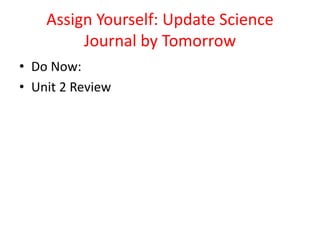
Update Science Journal with Natural Selection Notes
- 1. Assign Yourself: Update Science Journal by Tomorrow • Do Now: • Unit 2 Review
- 2. For your journal, you need to have: • All Unit 2 Notes cut and pasted in • ***HUGE TIP: If you have the notes already filled in, use those or it will be MORE work over the weekend!!!***
- 4. What is an organism? • Any living thing (animal, plant, bacteria, etc.)
- 5. Processing Piece: • Write “organism” and draw a picture to show what it means.
- 6. What is a population? • A group of organisms
- 7. Processing Piece: • Write “population” and draw a picture to show what it means.
- 8. What is natural selection? • A process that causes populations to change over time.
- 9. Processing Piece: • Write “natural selection” and draw a picture to show what it means. • Next to it, write “change over time.”
- 10. What 2 things do you need in order for there to be natural selection? 1. There must be variation in the population. – “Variation” = different traits – Examples: giraffes that are different heights
- 11. What 2 things do you need in order for there to be natural selection? 2. Some traits must be more advantageous than others. – “Advantageous” = gives the organism an advantage; helps it survive – Example: taller giraffes can reach higher leaves
- 12. How does natural selection work? 1. There is variation and an advantageous trait in a population. 2. More individuals with that trait survive. 3. They reproduce more, creating offspring (kids) that also have the trait. Over multiple generations… 4. That trait becomes more common in the population.
- 13. Example: Moths on trees Peppered moths can be light or dark. This is an example of variation (different traits).
- 14. Example: Moths on trees When trees had white bark, the ___________ moths survived better, because it was harder for predators like birds to see them. Tree trunk Light moth Dark moth
- 15. Example: Moths on trees When trees had white bark, the light moths survived better, because it was harder for predators like birds to see them. Tree trunk Light moth Dark moth
- 16. Example: Moths on trees Since light moths survived better, they had more offspring. Since they had more offspring, most of the population was light colored. Population Most moths are light. Light moth Dark moth
- 17. Example: Moths on trees Due to pollution, the tree bark became dark. When this happened, the _____________ moths survived better. Tree trunk Light moth Dark moth
- 18. Example: Moths on trees Due to pollution, the tree bark became dark. When this happened, the dark moths survived better. Tree trunk Light moth Dark moth
- 19. Example: Moths on trees Since dark moths survived better, they had more offspring. Since they had more offspring, over time, most of the population became dark colored. Population Most moths are dark. Light moth Dark moth
- 20. Processing Piece: • Illustrate each step of natural selection. 1. There is variation and an advantageous trait. 2. More individuals with that trait survive. 3. They reproduce more. Over several generations… 4. That trait becomes common. Use the moth example, or any other example you want.
- 22. Announcement! • Retest during lunch. • If you failed, you MUST come and retest.
- 23. Exit Ticket 1. Does natural selection change individuals or populations over time? 2. If trees are dark colored, which will have more offspring: light moths or dark moths? 3. Did you do as well on the test as you thought you did? 4. Why do you think you got the grade you got?
- 24. Assign Yourself: Finish Quackers Questions • Do Now: • Review of Unit 2, numbers 1-6
- 25. Exit Ticket: • 1. Why were the dark quackers more fit (ability to survive more)? • 2. During natural selection, what changes over time: individuals or populations? • 3. What was the variation of traits between the quackers? • 4. Did the population change instantly or over multiple generations?
- 26. Thirsty for T-STEM Thursday!!! An Anthropologist! • What do they do?
- 27. Keyfacts: • Hours: 50-60 • PhD Needed • TRAVEL A LOT to different countries
- 28. Lifestyle
- 29. Assign Yourself: IA2 Review • Do Now: • Natural Selection Review 1-4
- 30. Let’s grade our notebooks • Please take your notebook out. You have 30 seconds to have it on your desk and ready to grade.
